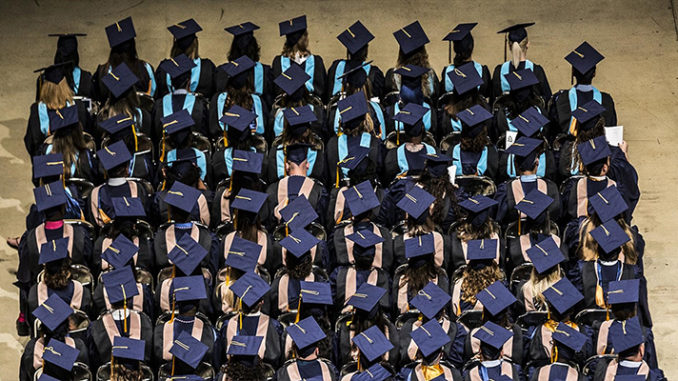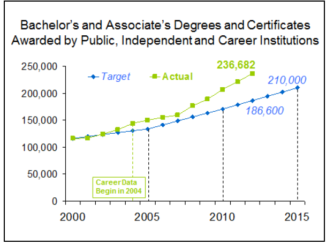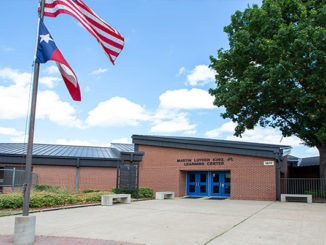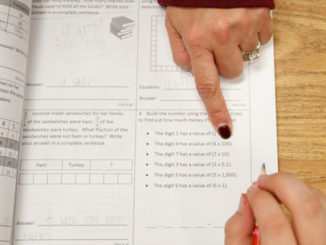
by Frederick M. Hess & RJ Martin
This fall, 2.5 million students will enroll in college for the first time. But how many will actually complete their degrees? A lot fewer than you might expect. Less than half of students at four-year colleges graduate within six years, and not even 40 percent of students at two-year institutions finish within three. For these students, dropping out comes at a cost of thousands — or tens of thousands — sunk into tuition and student loans, with little benefit on the job market, and without much else to show for it other than wasted time and energy.
Yet, when higher education shows up on cable news or in political speeches, this issue rarely merits a mention. Instead, there’s a rush to talk about ways to get more people into college or have taxpayers subsidize more of the cost. The thing is, it doesn’t matter how many students enroll in college — what matters is how many earn a degree. Otherwise, all this new college spending amounts to throwing good money after bad.
So, what might be done? One answer is to pass a law which punishes colleges that don’t get their graduation rates up, or rewards the colleges that do. Such an approach is simple, appealing — and dumb. It would give colleges incentive to boost their graduation rates by admitting only the most accomplished students, shutting the doors of opportunity on many others.
Colleges would also have cause to act more like diploma mills, doing whatever it takes to ensure that students get their credentials — even if it means cutting corners, giving a pass for subpar work, or just offering Mickey Mouse classes. In other words, if policymakers order colleges to graduate more students, it’s a safe bet that colleges will find a way to do it — even if the results look nothing like what those policymakers had in mind.
If policy-fueled accountability isn’t the answer, then what? If the goal is to maximize the chance that those students able and willing to do the requisite work will earn their degrees, there are a number of promising initiatives worth exploring. Those mentioned here, and a number of others, are sketched out in a new book on college completion, issued jointly by the American Enterprise Institute and Third Way.
For one, colleges can offer more holistic financial and academic support to disadvantaged students. The City University of New York (CUNY) enrolls over 25,000 low-income students whose academic records fall just below regular admissions standards. These students are enrolled through targeted programs called SEEK and ASAP, which assign participating students to counselors who have low caseloads; provide students extensive academic tutoring to help them catch up; and guarantee enough grant aid to cover tuition, fund transportation, and defray the cost of books. The results are promising: A 2015 evaluation found that 40 percent of ASAP participants graduated, compared to only 22 percent of similar students not enrolled in the program. And the benefits of this holistic support extend beyond graduation — alumni of SEEK earn up to $4,000 more per year than similar students.
Colleges can also coach students to maintain a long-term vision of success. One experiment by Stanford researchers Eric Bettinger and Rachel Baker randomly assigned about half of 13,000 college students to a trained mentor, who provided two years of consistent college coaching. This coaching focused on developing goals and connecting students’ daily activities with their long-term visions. Students who received coaching were 15 percent more likely to remain in college than were other students. Bettinger and Baker calculated that this tutoring, which cost $1,000 per student each year, is more cost-effective than additional financial aid: An extra $1,000 in annual financial aid has only a fraction of mentoring’s impact on retention.
There are other programs that support students effectively without in-person mentoring. In 2016, a team of researchers randomly assigned interactive online interventions to 9,000 college-ready high school seniors. These interventions stressed that intellectual ability can develop over time and that students from disadvantaged backgrounds can find college to be socially and culturally comfortable. After one year in college, disadvantaged students who had received these interventions narrowed the achievement gap between themselves and their more advantaged peers by up to 40 percent — and were significantly more likely to enroll full-time for the entire first year of college than were students who didn’t receive the online programming.
And yet another intriguing approach involves providing emergency aid to students at risk of dropping out. Georgia State University makes emergency grants to juniors and seniors when they are unable to register for classes because of unpaid balances. University staff scan “drop lists” for students who are on track to graduate but who have modest unpaid balances and then deliver aid straight to the student’s account, so long as the student agrees to conditions (such as meeting with a financial advisor to plan how to pay for the rest of the degree). This approach offers students crucial aid, while taking care to avoid red tape and to minimize moral hazard. The university has made over 10,000 such grants since 2011, with an average value of $900. One year after receiving a grant, 82 percent of recipients are still enrolled or have graduated.
None of these programs were mandated by national policy. Yet they are making a real difference in students’ lives. These initiatives work because they’ve been tailored with an eye to what’s needed by these students at these campuses. Here’s hoping that other colleges are taking a close look, because these are the kinds of reforms most likely to bring meaningful progress on the completion challenge.
Frederick M. Hess is director of education policy studies at the American Enterprise Institute. RJ Martin is a research assistant at AEI.



